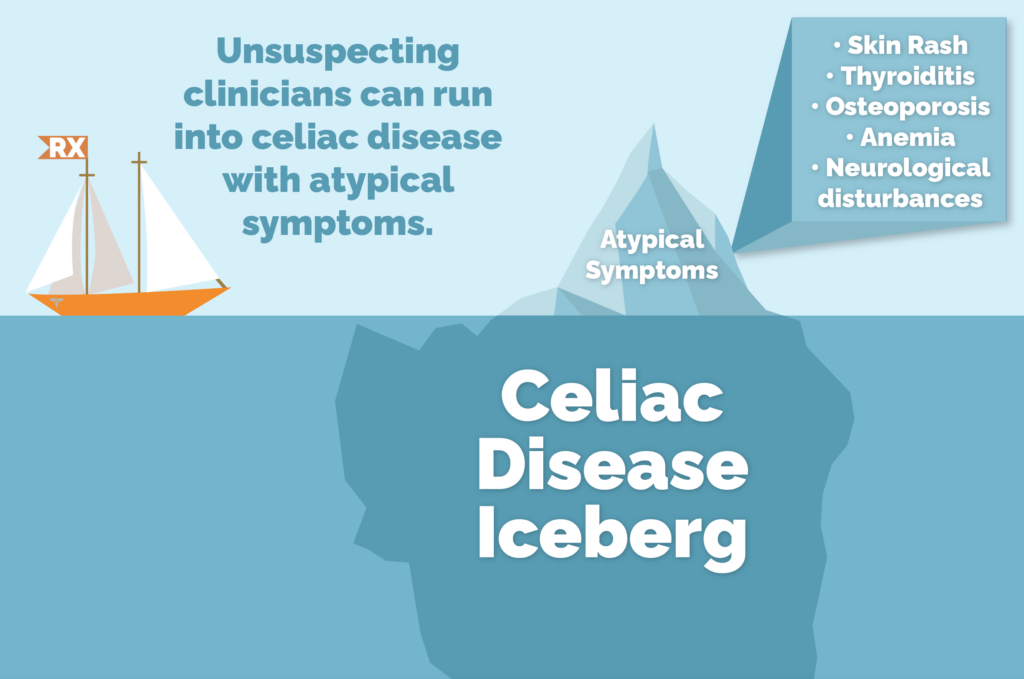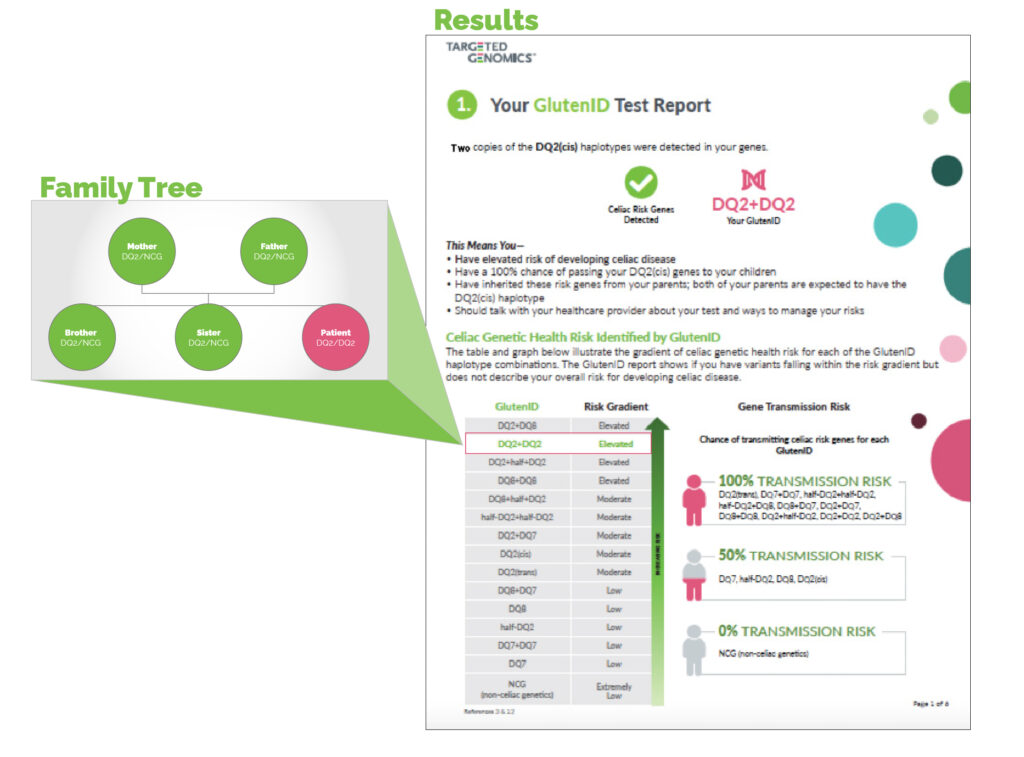
Did you know Celiac Disease can present as a Skin Rash?
Celiac disease is an autoimmune disorder in which the immune system attacks the small intestine and other tissues. One of those “other tissues” is the skin!
In this month’s issue we hear about an infant who developed mild GI symptoms and a distinctive rash soon after starting solid foods including wheat products.
His silent celiac disease story story is illustrated by the submerged part of the Silent Celiac Disease Iceberg. This is where atypical celiac disease often goes unrecognized.
Voices of Silent Celiac Disease: An Infant’s Story
In 2020 a previously healthy infant developed mild GI symptoms and a symmetrical blistering itchy rash covering both buttocks. Of note solid foods including wheat products had recently been introduced into his diet. His rash persisted over several weeks and was evaluated via pediatric telemedicine because of the COVID-19 lockdown. The diagnosis was allergic reaction to a cat (even though the family did not own one) and topical steroids were started with no improvement in the rash. The child’s grandmother, a pathologist, recognized the blistering skin lesions to be a celiac disease associated rash called dermatitis herpetiformis. She suggested trial of a gluten free diet to see if the rash improved. Within a few weeks of eliminating gluten, the child was completely asymptomatic.
Does resolution of the child’s symptoms on a gluten free diet make the diagnosis of celiac disease?
What is Silent Celiac Disease: a Quick Guide
Who has silent celiac disease?
Silent celiac disease can only only present in people who carry the celiac genetic risk genes DQ2 and/or DQ8. An estimated 40% of the world population have inherited these genes which allow the immune system to make antibodies against the gluten proteins in wheat, rye, and barley. These ”auto-antibodies” attack tissues in the gut and other organs causing a variety of GI symptoms as well as atypical non-GI symptoms. Atypical celiac disease symptoms are now known to be more common than typical GI symptoms!
How can you test for silent celiac disease?
Always start with with genetic risk screening for celiac associated genes DQ2 and DQ8. If screening is negative, silent celiac disease can be ruled out. If testing is positive, celiac disease diagnostic testing is the next step.
What is the difference between genetic screening and diagnostic testing?
A genetic screen is intended to identify individuals who would benefit from the two more invasive gold standard celiac disease diagnostic tests:
- tTG antibodies
- Small bowel biopsy
These tests are only necessary for individuals who are positive for the celiac risk genes. Without the risk genes there is no need for diagnostic testing because celiac disease has been ruled out!
Healthcare Provider Perspective

According to the pediatric gastroenterologist Alessio Fasano MD, celiac disease diagnosis should not be complicated if some simple rules are followed.
Dr. Fasano recommends using the ”4 out of 5” rule where celiac disease is confirmed if at least 4 out of 5 of the following criteria are satisfied:
- Celiac disease symptoms are present
- tTG antibody testing is positive
- Small bowel biopsy is positive
- Celiac risk genes DQ2 and DQ8 are positive
- Response to a gluten free diet
In this child’s case only two criteria have been satisfied.
What are the best next steps?

Proactive Family Screening Recommendation from the Mayo Clinic
A recent Mayo clinic study calls for proactive screening of celiac disease patients’ family members. This is because first-degree relatives of people with celiac disease are at elevated risk for also having the disease. The study calls for screening of all family members, not just those with symptoms.
In the case of our child with the rash, his diagnosis had not yet been confirmed by the 4 out of 5 rule. Only two criteria had been met with his celiac symptoms resolving on a gluten free diet.
Which of these options is the best next step?
- tTG antibody testing
- Small bowel biopsy and/or punch biopsy of his skin rash
- Testing for celiac risk genes DQ2 and DQ8.
Celiac Genetic Risk Screening versus Diagnostic Testing: What is the difference?
The purpose of genetic risk screening is to detect risk factors for silent disease in apparently healthy individuals.
Diagnostic testing establishes the presence (or absence) of disease for decision making about additional testing and treatment.
| Genetic Risk Screening | Diagnostic Tests | |
|---|---|---|
| Purpose | Identify those at risk and confirm diagnosis | Establish presence/absence of disease |
| Target | Asymptomatic but potentially at-risk individuals | Symptomatic individuals or asymptomatic individuals with positive genetics |
| Method | Should be simple to perform for patients and physician office staff | May be invasive such as small bowel biopsy but justified to establish the diagnosis |
| Positive Genetics | Diagnostic testing necessary for symptomatic individuals | Positive genetics help confirm diagnosis using 4/5 rule |
| Negative Genetics | Rules out presence or future development of celiac disease. | No diagnostic testing needed |
| Cost | Less expensive than diagnostic tests | Higher costs justified to establish a celiac disease diagnosis |
The Family’s Decision about Testing Options

Test Results and Family Tree

Since their child was thriving on a gluten free diet, his parents opted not to put him through a gluten challenge. This would have re-triggered his disease by adding gluten products to his diet in preparation for tTG antibody testing and small bowel/skin biopsies.
Instead, his parents opted for screening themselves and all three children using the GlutenID Celiac Genetic Risk test. All samples were collected at home by the family using cheek swabs and sent to the lab in the GlutenID test kit box.
The child’s parents both had copies of the DQ2 gene which were transmitted to the child with suspected celiac disease. His sister inherited one DQ2 copy from her father and his brother inherited the low risk DQ7 gene from his father.
Does the child now have a diagnosis of celiac disease?
Here are some of the Gluten Free recipes the child’s mother says he enjoys!
Answering your Questions about Silent Celiac Disease
References
- Celiac genetic health risk screening by NGS in the family of a child with clinical findings of dermatitis herpetiformis and gluten sensitivity https://targeted-genomics.com/glutenid-testing-featured-in-cap-today/
- Celiac Disease Diagnosis: Simple Rules are Better than Complicated Algorithms https://iris.univpm.it/bitstream/11566/54123/1/CD%20Diagnosis%20Am%20J%20Med%202010.pdf
- The celiac iceberg: What Textbooks do not Clarify and Beyond https://www.mednet.gr/archives/2010-6/pdf/891.pdf








